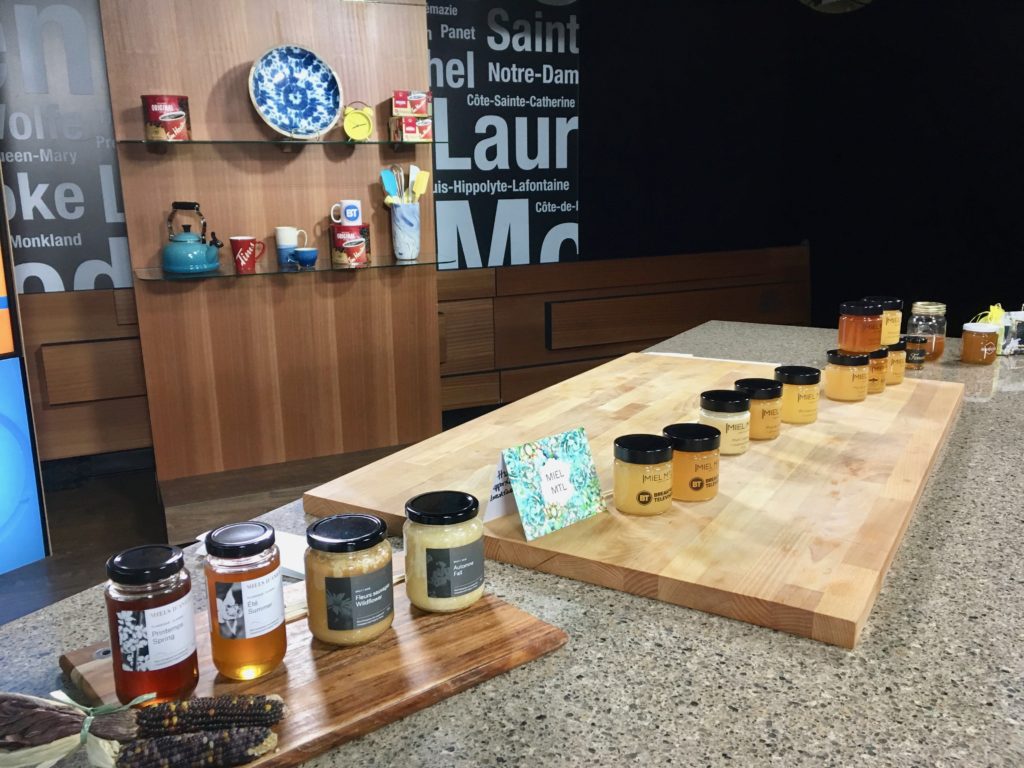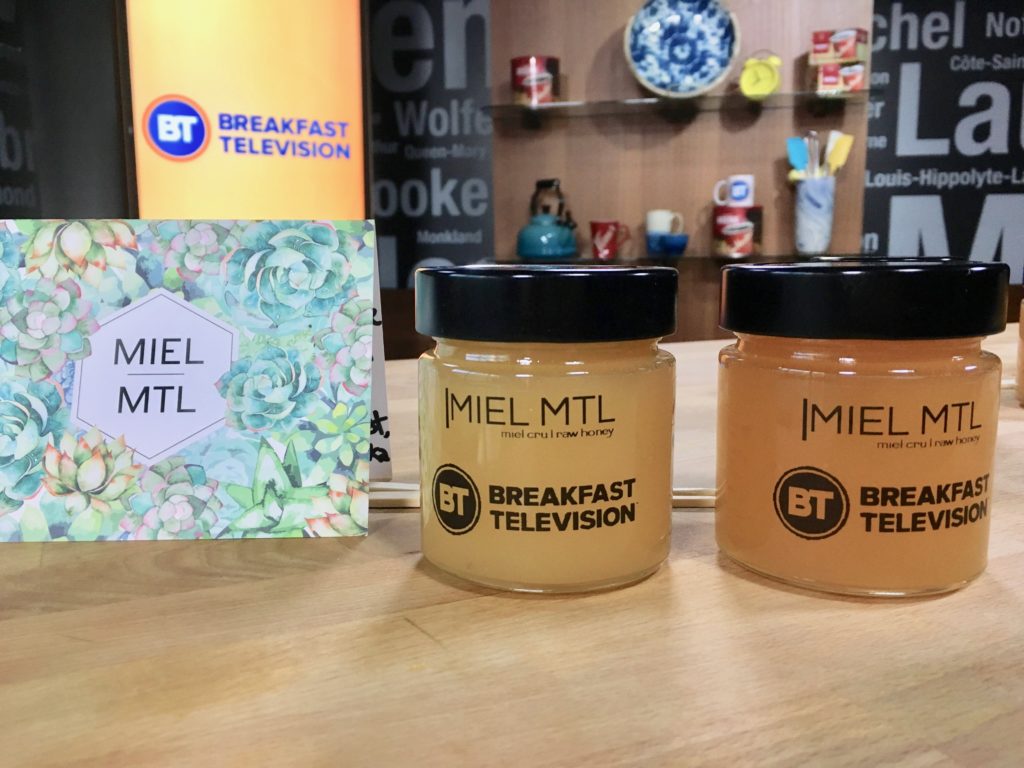If you missed my segment this morning on urban honeys on BT Montreal, here it is:
Host Derick Fage and I tasted our way through Verdun, NDG, the South Shore, the Mile-End and Downtown via the honeys of Miel MTL, Ferreira Café, The Dépanneur Café. We also tried some honeys from Les Miels d’Anicet.
There were some things we didn’t get to talk about on the segment, though, including Claudia Ferreira’s beautiful webseries Portugal Gourmand, where she travels to Portugal to meet the artisans behind some of the fish, pork, sea salt, wine and, yes, honey, that Portugal produces (a lot of those products also happen to end up on the Ferreira menu). She also generously gave me a bunch of packages of wildflowers for people to plant to attract honey bees. The crew at Breakfast Television will be planting those soon, I hope.
We also didn’t get to talk about how raw honeys can hep with seasonal allergies, or how honey never goes bad (tip: if you have a liquid honey that develops crystals on top, you can gently melt it – the only thing that can go bad are pieces of food that get stuck in the honey if you double-dip!)
And, most importantly, I didn’t get to say thanks to Benoît Bigham of the Dépanneur Café, Claudia Ferreira of the Ferreira restaurants (F Bar, Campo, Vasco da Gama and the eponymous Ferreira Café), Nicholas Melka of Miel MTL and Anne-Virginie and Anicet of Les Miels d’Anicet. You can find Miel MTL’s neighbourhood honeys online and at some stores and markets around Montreal. Les Miels d’Anicet are in fine foods stores, including the new Marché d’Artisans in the Fairmont Queen Elizabeth, but they also have an online boutique (plus a new line of skincase products) and a new seasonal cantina at their farm where they serve food and hydromels (honey wines) made by Anne-Virginie’s sister-in-law. And you might be able to try Benoît and Claudia’s honey at their restaurants, but there won’t be any at the Dépanneur Café until I give back the rest of Benoît’s last jar!
So here are my notes from the segment, plus some photos of the set:

I have urban honeys from different Montreal neighbourhoods from Miel MTL, honey from the two beehives on top of Ferreira restaurant on Peel St., honey from Benoit Bigham’s hive on top of the Café Depanneur in the Mile End, and honeys from Les Miels d’Anicet in Ferme-Neuve, QC, about 3 hours northwest of Montreal.
I included the non-urban honeys from Les Miels d’Anicet because Anicet and Anne-Virginie raise and sell queen bees to the majority of beekeepers in Quebec, including Miel MTL.
And their raw, unpasteurized autumn honey is my personal favourite honey in Quebec. It tastes to me like there’s a tiny bit of mint to it, so it cools your tongue as it melts. This is something I’d take a half spoonful of by itself in the morning. Or with nuts or cheese or fruit. I’d never heat it or dilute it in something where I wouldn’t actually taste the flavour of the honey.
To me, it’s like the Champagne of honey.
- Why do you get such big differences in colour and flavour?
It all depends on the type of flowers nearby and the season, because different plants flower in the spring, summer and fall. And honey bees stays within 3km of their hives. So you end up with very localized honeys. So this autumn honey from Les Miels d’Anicet is mostly made up of Goldenrod, which is a plant the aster family. But in summer the bees harvest pollen from more clover and raspberry bushes, so you’ll get a lighter colour. And buckwheat is going to be one of the darker, richer, more caramel flavours.
- So you even get differences in colour and flavour between honeys even when they’re all produced in and around Montreal like the rest of the honeys you have here?
Yes! The flowers are different!
- How much does a single hive produce?
Let’s just say you’re not going to make tons of money by selling the honey that one hive produces in your first year. Benoit Bigham of the Café Depanneur in the Mile End and Claudia Ferreira of the Ferreira restaurants both have hives from Alvéole on their roofs. Alveole is a company that partners with people and restaurants to teach them to be beekeepers.
Benoit doesn’t even produce enough honey just for his café. Claudia doesn’t produce enough for Ferreira, Vasco da Gama, F Bar and Campo, the family restaurants. But it’s a labor of love that’s delicious, local and good for the environment. This honey we have today is the last of Benoit’s honey for the year. That’s precious honey!
And Claudia’s so passionate about bees that she went to an apiary in Portugal as part of a webseries called Portugal Gourmand that’s short episodes of her visiting artisanal honey, salt, pork and wine producers in Portugal, whose products often end up on the Ferreira restaurant menu. You can watch the episodes at portugalgourmand.com
- Is it dangerous to have honey bees in the city? Can they swarm?
Honey bees are actually vegan! They just want to collect nectar and pollen, says Nicholas Melka of Miel MTL. 99.9% of honey bees will never sting you. Miel MTL has never had a single complaint. They partner with local schools, businesses, restaurants, families and organizations to set up and sustainably harvest beehives and they do weekly inspections on the hives so they can see signs that a hive might swarm and prevent it from happening.
- Are there too many bees in Montreal?
There are more and more restaurants and businesses that are partnering with Miel MTL and Alvéole to get beehives on their roofs, but there aren’t too many. There are still areas of the city where you don’t see any honey bees, and bees are what pollinate about 30% of the world’s crops like coffee, apples, onions and strawberries and 90% of the world’s wild plants. No bees means more than 30% less food. And since they don’t fly more than 3km from their hives, you’d need a lot of them before the population was too dense.
- Why are some honeys grainier and some are fully liquid?
The grainier ones are completely unheated and unfiltered and they’re cold-extracted. The liquid ones heated at a very low temperature until they melt and then they’re filtered to give them the classic look of honey. But that heating kills some of the flavours and health benefits, like the honey’s digestion-aiding enzymes and anti-bacterial and anti-viral properties.
- Are urban honeys better than honeys coming from farms outside cities?
It depends on the farm. Les Miels d’Anicet are certified organic because they come from 150km along the Le Lièvre River, where there are no conventional farms using pesticides nearby. But often honey bees are pollinating flowers on nearby farms that are sprayed, which is a big reason honey bees are dying out. You don’t have to worry about this so much in the city because fewer plants are sprayed with pesticides than on a farm. What I love about urban honeys is that since the honey contains pollen from the area, eating it can help people with seasonal allergies build an immunity. If you’re traveling in a new place, one of the best ways to get exposed to new pollens and healthy bacteria in the area is to find, raw, unpasteurized local honey.

Leave a Reply